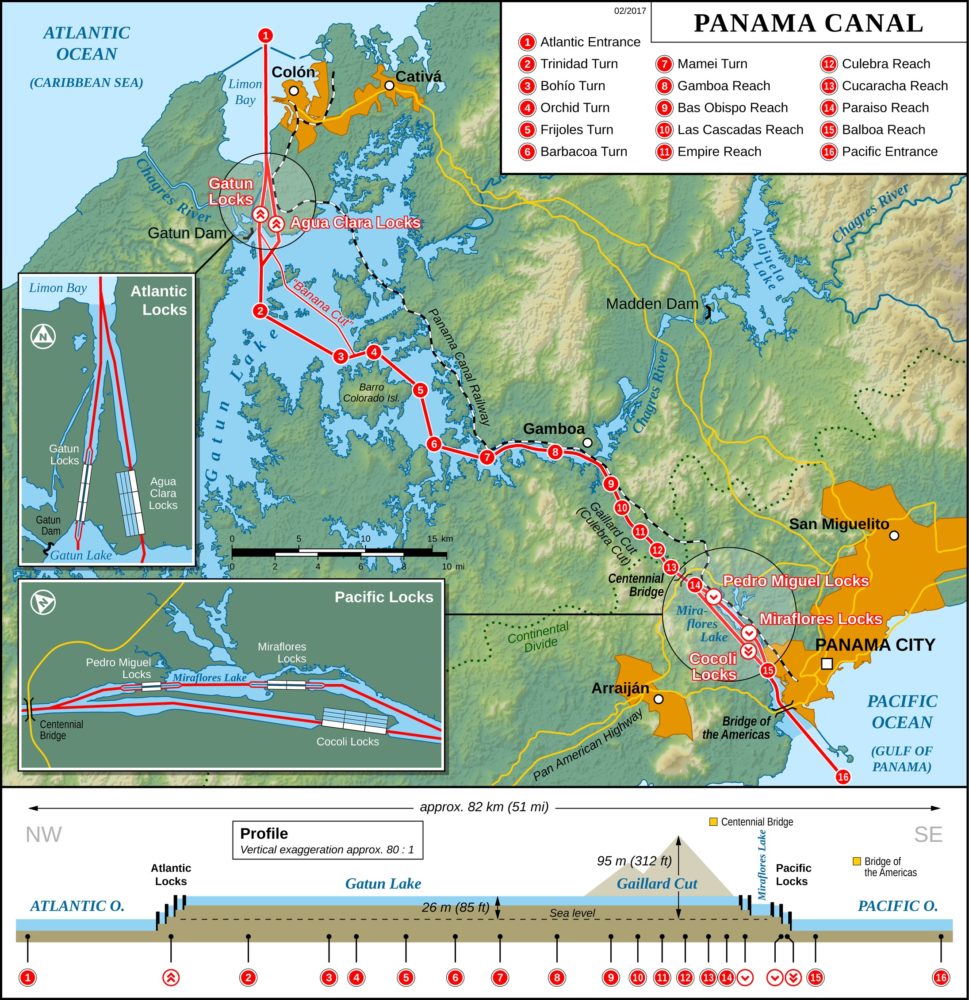It will thus be seen that President Nuñez, who was both a usurper and a dictator, arbitrarily annulled the constitution under which Panama consented to become a part of the Republic of Colombia.
Continuing USA Acquires Rights to Build the Panama Canal,
our selection from Speech to the US Senate by Chauncey M. Depew</a delivered on January 14, 1904. The selection is presented in 5 easy 5 minute installments. For works benefiting from the latest research see the “More information” section at the bottom of these pages.
Previously in USA Acquires Rights to Build the Panama Canal.
Time: 1903

CC BY-SA 2.0 image from Wikipedia.
In 1886 Mr. V. O. King, United States Minister to Colombia, in a dispatch to Mr. Bayard, Secretary of State, tells precisely how the Colombian Constitution was formed. He says:
At the close of the late revolution President Nuñez, whose term of office had then nearly expired and whose reelection was forbidden by the constitution then in force, issued a proclamation annulling that instrument and declaring an interregnum in the Government. He appointed provisional governors in all the nine States, and directed them to nominate two delegates each, who, together, should constitute a national council to convene at the capital. And this is the convention which is compared with that which formed our Constitution!“
On assembling in November, 1885, the first acts of this body were to ratify the conduct of Doctor Nuñez and to confirm his appointments. It then elected him as chief magistrate of the nation for the term of six years, and proceeded to formulate a project of fundamental principles for a new constitution to be submitted to the corporate vote of the municipal boards of aldermen throughout the country. Upon canvassing the returns the council — this council of his own — “declared a majority of such votes to be in favor of the new constitution, and thereupon proceeded to elaborate the instrument that is here with submitted, which, from the number, fullness, and precision of the precepts enunciated, has left but little of the machinery to be devised by the executive or legislative power.”
It will thus be seen that President Nuñez, who was both a usurper and a dictator, arbitrarily annulled the constitution under which Panama consented to become a part of the Republic of Colombia, retaining, however, her entire sovereignty and right of secession. The tremendous difference between the formation of our Constitution and that of Colombia in 1886 is in the fact that this so-called convention, which framed the constitution destructive of the State, was composed of the instruments of the dictator, appointed by himself, and that neither in the election of delegates to the convention nor in the ratifying of the treaty did the people of Panama or their representatives have any voice whatever!
Panama, an independent State, robbed by armies of her liberties, tyrannically and arbitrarily governed without her consent, suffering under intolerable tyranny and threatened with the confiscation of a public improvement upon which depended her existence, simply retakes, and demonstrates her ability to hold, the sovereignty of which she had been despoiled. But, say the critics of the President, the officers of the United States inaugurated this rebellion and ships were dispatched to aid the revolt before it ever was intended. No one doubts that it was the duty of the President to keep the highway open across the isthmus. No one doubts that if the rights of American citizens were in peril because of revolution or anarchy the United States must have a force on the spot sufficient for their protection.
The forces of the United States arrived at the isthmus on November 3rd. The revolution broke out on November 4th. The building of the canal was vital to Panama. Except for the money to be distributed at Bogota for the concession, its construction was of little account to the Republic over the mountains. The delegates from Panama to the Congress were apparently the only independent members of that body. When they arrived on July 5th they immediately notified Vice – President Marroquin that if the treaty was rejected Panama would revolt. This notification was so public that the Minister of the United States was enabled to write it to our Government.
On August 17th the treaty was rejected, and the representatives from Panama expressed their purpose so emphatically that our Minister was able to inform the Secretary of State that they had determined to break loose from the Bogotan Government and form an independent republic.
It is perfectly plain that these delegates, on returning in August to Panama, were joined by all the leading citizens, and that they had plenty of time between the middle of August and November 4th to perfect their plans for a successful revolution. So the President knew perfectly well by advice from our Minister at Bogota, from our naval officers at Panama and Colon, and from newspaper reports which were the common property of everyone, that such an uprising would occur as to require of the United States the presence of a force sufficient to protect our citizens and to carry out our treaty obligations.
| <—Previous | Master List | Next—> |
A. Maurice Low began here. Chauncey M. Depew began here.
More information here and here, and below.
 |
We want to take this site to the next level but we need money to do that. Please contribute directly by signing up at https://www.patreon.com/history
Leave a Reply
You must be logged in to post a comment.